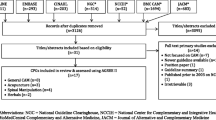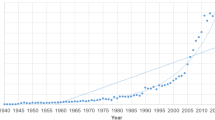Abstract
In recent years, there has been a growing interest about complementary and alternative medicine (CAM), and the use of CAM interventions has become more common among people. For these reasons, health professionals must be able to effectively manage information in this field of knowledge according to an evidence-based point of view. This study assessed the anatomy of the available information about CAMs using PubMed, to give practical instructions to manage information in this field. We also analyzed the anatomy of information according to each alternative medicine branch, narrow and broad search methods, subset filters for indexed-for-Medline and non-indexed citations, and different publication types including randomized controlled trials (RCTs) and meta-analyses. Our results demonstrated that the use of CAMs subset (supplied by PubMed search engine) leads to a great number of citations determining an information overload. Our data reveal that it would be more useful to search for the CAM separately, identifying specific items and study design. Moreover, we found the largest number of randomized clinical trials and meta-analyses related to herbal medicine and acupuncture, neither RCTs nor meta-analyses were available for bach and flower remedies, auriculoacupuncture, iridology, and pranotherapy. For the first time, our study gives a comprehensive view of the anatomy of information regarding CAMs and each branch of them. We suggest a methodological approach to face with searching information about this emerging issue from an evidence-based point of view. Finally, our data pointed out some “grey zones” since neither RCTs nor meta-analyses were available for some CAMs.


Similar content being viewed by others
References
DiCenso A, Bayley L, Haynes RB (2009) Accessing pre-appraised evidence: fine-tuning the 5S model into a 6S model. Evid-Based Nurs 12(4):99–101
http://nccam.nih.gov/about/budget/appropriations.htm. Accessed 22 Feb 2013
http://www.ncbi.nlm.nih.gov/pubmed/. Accessed 2 Feb 2013
Haynes RB, McKibbon KA, Wilczynski NL, Walter SD, Werre SR, Team Hedges (2005) Optimal search strategies for retrieving scientifically strong studies of treatment from Medline: analytical survey. BMJ 330(7501):1179
Corrao S, Colomba D, Arnone S, Argano C, Di Chiara T, Scaglione R, Licata G (2006) Improving efficacy of PubMed clinical queries for retrieving scientifically strong studies on treatment. J Am Med Inform Assoc 13(5):485–487
NCCAM: National Center for Complementary and Alternative Medicine (2013) Expanding horizons of health care. What is CAM? [Internet]. National Institutes of Health, Bethesda (MD). URL: http://nccam.nih.gov/health/whatiscam/. Accessed 22 Feb 2013
Firenzuoli F (2008) Fitoterapia, 4th edn. Elsevier, Milano
Ritchie MR (2007) Use of herbal supplements and nutritional supplements in the UK: what do we know about their pattern of usage? Proc Nutr Soc 66:479–482
Barnes PM, Powell-Griner E, McFann K, Nahin RL (2004) Complementary and alternative medicine use among adults: United States, 2002. Adv Data 27:1–19
Quan H, Lai D, Johnson D, Verhoef M, Musto R (2008) Complementary and alternative medicine use among Chinese and white Canadians. Can Fam Physician 54:1563–1569
Leung L, Kotecha J (2008) Complementary and alternative medicine [fast facts] Can Fam Physician 54:1529. CFplus. http://www.cfp.ca/cgi/data/54/11/1529/DC1/1. Accessed 22 Feb 2013
Sackett DL, Richardson WS, Rosenberg W, Haynes RB (1997) Evidence-based medicine: how to practice and teach EBM. Churchill Livingstone, New York
Conflict of interest
None.
Author information
Authors and Affiliations
Corresponding author
Appendix: terms and strings used to perform full PubMed searches
Appendix: terms and strings used to perform full PubMed searches
1# CAM [sb]
2# (Phytotherapic or phytotherapy or phytotherapeutical)
3# Acupuncture
4# [Massage not (cardiac or resuscitation or perineal or prostatic)]
5# Chiropractic
6# (Homeopath* or homeopathy)
7# Aromatherapy
8# [Osteopathic medicine or (manipulative or manipulation) and osteopathic]
9# (Ayurveda or ayurvedic or ayur veda or ayur vedic)
10# Reiki
11# (Reflexology or reflexotherapy)
12# Kinesiology
13# (Naturopathy or naturopathic or naturopathical)
14# {Bach e [ps] or flower remedies or (bach AND flower)}
15# (Anthroposophy or anthroposophical or anthroposophic)
16# Color therapy
17# Shiatsu
18# (Auriculoacupuncture)
19# (Iridolog* or iridodiagnosis)
20# (Pranic or pranotherapy or pranotherapeutic or pranotherapeutical)
Rights and permissions
About this article
Cite this article
Corrao, S., Argano, C., Colomba, D. et al. Information management and complementary alternative medicine: the anatomy of information about CAMs through PubMed. Intern Emerg Med 8, 627–634 (2013). https://doi.org/10.1007/s11739-013-0997-8
Received:
Accepted:
Published:
Issue Date:
DOI: https://doi.org/10.1007/s11739-013-0997-8




